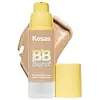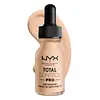What's inside
What's inside
 Key Ingredients
Key Ingredients

 Benefits
Benefits

No benefits
 Concerns
Concerns

 Ingredients Side-by-side
Ingredients Side-by-side

Water
Skin ConditioningZinc Oxide
Cosmetic ColorantOctyldodecanol
EmollientButyloctyl Salicylate
Skin ConditioningCaprylic/Capric Triglyceride
MaskingEthylhexyl Olivate
Skin ConditioningGlycerin
HumectantMica
Cosmetic ColorantC13-15 Alkane
SolventPolyglyceryl-3 Polyricinoleate
EmulsifyingPropanediol
SolventCalcium Sodium Borosilicate
Disteardimonium Hectorite
StabilisingGlyceryl Oleate
EmollientPentylene Glycol
Skin ConditioningSodium PCA
HumectantSqualane
EmollientPullulan
Sclerotium Gum
Emulsion StabilisingTrehalose
HumectantSodium Hyaluronate
HumectantCopper Tripeptide-1
Skin ConditioningTocopherol
AntioxidantLavandula Stoechas Extract
MaskingSilica
AbrasiveSaccharide Isomerate
HumectantSalicornia Herbacea Extract
Skin ConditioningAscorbyl Palmitate
AntioxidantSodium Gluconate
Skin ConditioningPolyhydroxystearic Acid
EmulsifyingXanthan Gum
EmulsifyingLecithin
EmollientTocopheryl Acetate
AntioxidantIsostearic Acid
CleansingSodium Chloride
MaskingHydrogenated Palm Glycerides Citrate
EmollientPhenethyl Alcohol
MaskingCI 77891
Cosmetic ColorantCI 77491
Cosmetic ColorantCI 77492
Cosmetic ColorantCI 77499
Cosmetic ColorantWater, Zinc Oxide, Octyldodecanol, Butyloctyl Salicylate, Caprylic/Capric Triglyceride, Ethylhexyl Olivate, Glycerin, Mica, C13-15 Alkane, Polyglyceryl-3 Polyricinoleate, Propanediol, Calcium Sodium Borosilicate, Disteardimonium Hectorite, Glyceryl Oleate, Pentylene Glycol, Sodium PCA, Squalane, Pullulan, Sclerotium Gum, Trehalose, Sodium Hyaluronate, Copper Tripeptide-1, Tocopherol, Lavandula Stoechas Extract, Silica, Saccharide Isomerate, Salicornia Herbacea Extract, Ascorbyl Palmitate, Sodium Gluconate, Polyhydroxystearic Acid, Xanthan Gum, Lecithin, Tocopheryl Acetate, Isostearic Acid, Sodium Chloride, Hydrogenated Palm Glycerides Citrate, Phenethyl Alcohol, CI 77891, CI 77491, CI 77492, CI 77499
 Reviews
Reviews

Ingredients Explained
These ingredients are found in both products.
Ingredients higher up in an ingredient list are typically present in a larger amount.
Ci 77491 is also hydrated iron III oxide. It's sole purpose is to give a red/pink hue to products.
Iron III oxides are classified as inorganic chemicals for coloring.
Synthetically created Ci 77491 is considered safer than those naturally found. This is because the synthetically created version may contain less impurities. Iron oxides are generally non-toxic and non-allergenic.
Learn more about CI 77491Ci 77492 is also hydrated iron III oxide. It's sole purpose is to give a yellow hue to products.
Iron III oxides are classified as inorganic chemicals for coloring.
Synthetically created Ci 77492 is considered safer than those naturally found. This is because the synthetically created version may contain less impurities. Iron oxides are generally non-toxic and non-allergenic.
Learn more about CI 77492Ci 77499 is also hydrated iron III oxide. It is created from mixing red and black iron oxides. This helps give shades of darkness to a product.
Iron III oxides are classified as inorganic chemicals for coloring.
Ci 77891 is a white pigment from Titanium dioxide. It is naturally found in minerals such as rutile and ilmenite.
It's main function is to add a white color to cosmetics. It can also be mixed with other colors to create different shades.
Ci 77891 is commonly found in sunscreens due to its ability to block UV rays.
Learn more about CI 77891Silica, also known as silicon dioxide, is a naturally occurring mineral. It is used as a fine, spherical, and porous powder in cosmetics.
Though it has exfoliant properties, the function of silica varies depending on the product.
The unique structure of silica enhances the spreadability and adds smoothness, making it a great texture enhancer.
It is also used as an active carrier, emulsifier, and mattifier due to its ability to absorb excess oil.
In some products, tiny microneedles called spicules are made from silica or hydrolyzed sponge. When you rub them in, they lightly polish away dead skin layers and enhance the penetration of active ingredients.
Learn more about Silica